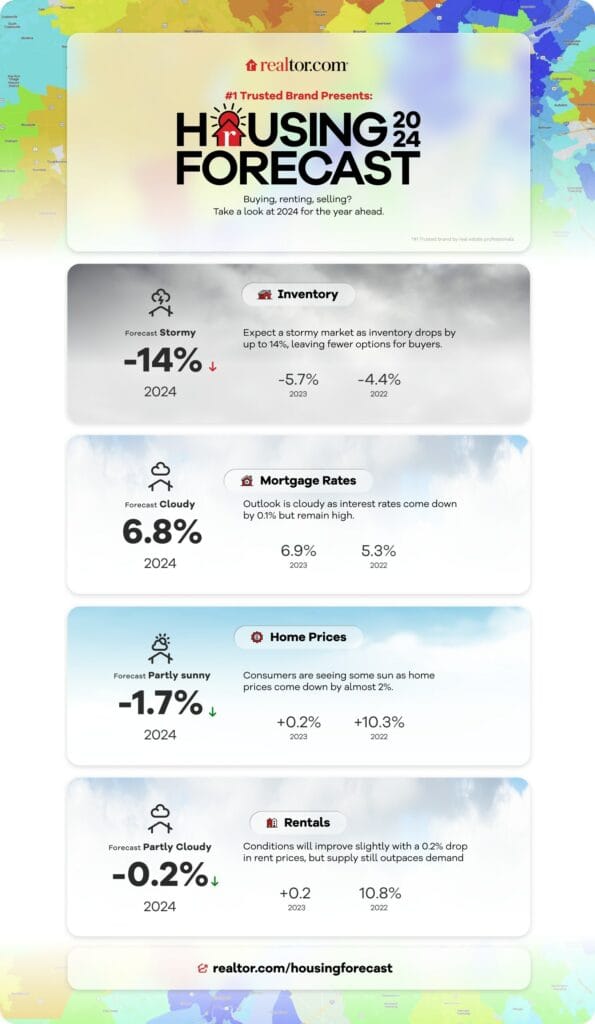NYS Gaming Commission Approves Three Casino Licenses in the Bronx and Queens
The Gaming Commission also approved a rule change that altered the term of the casino license depending on the amount of investment.
Lower mortgage rates and easing prices will spark an affordability turnaround, but tight inventory will make renting a competitive option in most markets.

SANTA CLARA, CA—Lower mortgage rates and easing prices will help spark the beginning of an affordability turnaround in 2024, according to the Realtor.com 2024 Housing Forecast released recently. But the supply of existing homes will still be tight and renting will remain a competitive option in most markets.
Overall, in 2024, Realtor.com forecasts that buyers and sellers can expect:
“Our 2024 housing forecast reveals the green shoots we've been waiting to see in the housing market and should give buyers some optimism after a grueling few years. Although mortgage rates are expected to ease throughout the course of the year, the continuation of high costs will mean that existing homeowners will continue to have a high threshold for deciding to move, but we will start to see some interest,” said Danielle Hale, chief economist for Realtor.com. “Moves of necessity—for job changes, family situation changes, and downsizing to a more affordable market—are likely to drive home sales in 2024. Home buyers will continue to seek out markets where they feel like they get the most out of their dollar as they look for homes that better meet their needs.”
For the New York-Newark, NY-NJ-PA, Realtor.com predicts sales to fall 10.8% in the region in 2024, while prices will increase 3.0% as compared to 2023.
Affordability will officially turn around in 2024. In 2024, the typical monthly purchase cost for the median-priced home listing is expected to be slightly less than $2,200/month, or about 35% of the typical household income. That's an improvement from 2023, when purchase costs ate up nearly 37% of income and the typical for-sale home cost $2,240. This tick-up in affordability will give a foothold to some buyers trying to break into the market. Buyers planning to get into the market this year should use Realtor.com's Buying Power tool, which uses results from the affordability calculator to tag homes as “affordable,” "stretching," or "difficult" based on typical lending criteria.

Even more sellers hang back, but they could get motivated if rates drop faster than forecasted. Despite the fact that builders have been catching up, the lack of excess capacity in housing has been obvious over the last few years. With home sales activity forecasted to continue at a relatively low pace, the number of unsold homes on the market is also expected to remain low. But if rates drop faster than expected (which is possible given the roughly half-point decline seen in November 2023), this could lessen rate lock sooner and bring more homes to the market than forecasted.
Shiny new rental construction will hit the market. A once-hot rental market has slowed down, with the rental vacancy rate rising slightly, up to 6.6% in the third quarter of 2023, about where it was right before the pandemic. In 2024, an increase in new rentals will help push vacancy higher, closer to the 7.2% average seen from 2013-2019. While the surge in new rental options gives renters more to choose from, the sheer number of renters will minimize the potential price impact. The median asking rent in 2024 is expected to drop only slightly below its 2023 level (-0.2%).
Sellers should be ready to compete with new construction. Home sales will likely be driven by moves of necessity in 2024. And even with the lower inventory of existing homes, sellers will be competing with new housing. Single-family home housing starts will increase an estimated 0.4% in 2024. Sellers will need to look at the new construction market in their area to make sure pricing and marketing are competitive.
Geopolitics and inflation are among 2024's wildcards: Even as markets adjusted to Russia's war in Ukraine, conflict in the Middle East heated up to historic levels in the fourth quarter of 2023. Both wars have the potential to affect the global economy in ways that can't be fully anticipated. On the domestic front, the 2024 election season, with its attendant uncertainty, will be in full swing. And while inflation is expected to continue to subside, anything that reverses that trend could raise long-term interest rates, and in turn nudge mortgage rates higher than expected. That might discourage potential sellers from making a move and could keep potential buyers on the sidelines, putting a damper on home sales.
“Buyers and sellers who are planning to get into the market this year should be prepared. Tools like Realtor.com's RealCost rent vs. buy and affordability calculators can help buyers ensure they are making a sound financial decision based on current interest rates and their personal financial situation. Sellers can use the RealValue tools in Realtor.com's My Home to understand what their proceeds from a sale could be and plug this data into our mortgage payment calculator with current interest rates to understand exactly how much they would pay each month with a new home purchase. Additionally, everyone can see what our projections mean for home prices around the country by checking out the forecast layer in our RealView mapping tool,” Hale added.
Receive original business news about real estate and the REALTORS® who serve the lower Hudson Valley, delivered straight to your inbox. No credit card required.